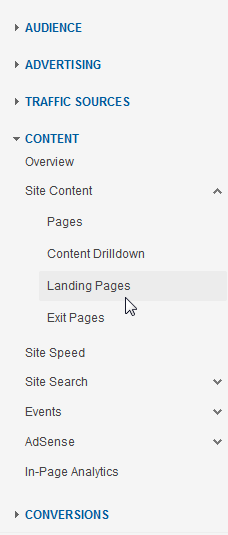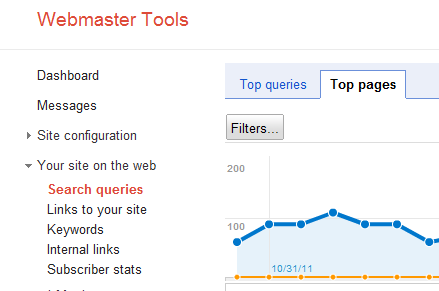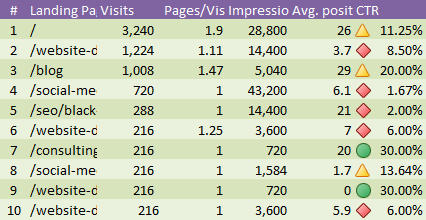Google took your keyword data away. Well, not completely but enough to make you cry. We all cried a little. But hey, you know what they say about gift horse and all that.
The main question is, are we helpless now? My answer is, you've got to be kidding. There is still plenty of usable data. In this post I am going to show you how a happy marriage of Google Analytics and Google Webmaster tools produces actionable insights. The data is made up and somewhat hidden.
Collect Data
First, combine data from Analytics and Google Webmaster Tools into one useful Excel spreadsheet.
- In Google Analytics, go to the Content -> Landing Pages. Export top 10 landing pages in CSV (not "CSV for Excel")
- Copy the data and paste Landing Page, Visits, Pages/Visit data into your master workbook. Name the sheet "Landing Pages", for example.
- In Webmaster Tools, go to Your site on the web -> Search queries -> Top Pages. Export the data as CSV. Make sure that the report dates are the same as your analytics data export.
- Copy the data into a separate sheet in your master workbook. Name it "WMT", for example.
- You will need to remove https://www.domain.com from the first column in the WMT sheet.
- In your master workbook (Landing Pages sheet), create headers Impressions and Avg. Position (columns D and E). Use VLOOKUP to populate the data. For example, to pull Impressions, you formula would look like this: =VLOOKUP(A2,WMT!A1:I59,2,FALSE).
- Add a column - CTR: =Visits/Impressions.
Your finished table will look something like this.
Insights
Now you are ready to flex your brain power and start populating your "to-do" list. Data analysis is your next step.
Start with CTR
Observation. Best converting pages are #7 and #9 judging by the click-through rate. Unfortunately, #7 page is stuck on the second page of SERPs and #9 is not even ranking. Moreover, visitors usually view just one page on your site, which means those pages are not "sticky".
Explanation. You can deduce from these numbers that your pages are quite relevant to search queries if searchers can find them. When they land on those pages, however, they do not feel inclined to explore your website any further. Look at time on page to see if visitors stayed to read the page or bounced back immediately.
Action. If those two pages are informational and your goal is to provide an answer to a searcher's question, then your first action item will be to improve ranking of that page. Second, consider clarifying call-to-action. It is great if people stay to read that page, but you need to push them ever so slightly to your conversion funnel.
Average Position
Isolate all the pages with average position of 1-10. Let's see how we are doing on the first page of the search engine results.
Observation. In our example, page #8 has average CTR. The other pages have poor CTR and are positioned lower on the page.
Explanation. It is clear, that your landing page does not match the searcher's question. However, the content is good enough for the page to rank high for the keywords. This can be a low hanging fruit: just by improving the page you can rank higher and increase CTR.
Action. For page #8 find out why it does not consistently rank #1. For the rest - improve CTR. If the CTR is low, then the title or description of your page does not meet the searcher's expectations. This is the time to look at the ranking keywords for this page, SERPs competition, test your Title tag and Description tag to achieve better CTR. But start with the best performing pages.
Pages Per Visit
Everyone wants their website to be "sticky". If searchers come to the site, read a little, buy a little, your pay check is safe. Let's see which pages are ensuring your job security.
Observation. Home page (#1) is moving people to other pages on the site best. Main blog page (#3) is sticky as well. Page #7 is somewhat effective and it is appearing on the first page of SERPs mostly.
Explanation. Home page is a completely different kind of page compared to the rest of the site. It is good that it funnels visitors through the site. But we can do better with blog stickiness. CTR for page #6 needs to be improved too.
Action. Page #6 can benefit from more intriguing short descriptions. After all, it is because of those teasers people click to read the whole article. Check usability on the rest of the pages: is it possible that the visitor is confused about what to do after they land on your page? Do all links work? Use tools like CrazyEgg to test where people are clicking on those pages.
Make a Plan
Now that you know your action items, prioritize them in order of most revenue. Are any of those pages conversion pages? Weigh your actions by the potential upside. For example, given the same CTR, how will your traffic increase if you move a page from position 5 to position 3? What about from the second page of SERPs to the first page?
Your business goals should have the most weight. Second come the efforts, i.e. how much work you will have to do to make the change happen. And third is the affect that the change will have on the other pages and on your whole site.
Another suggestion is to look only at the pages that you consider your main converting pages. If they are not in your top 20 or top 30 pages, you need to forge a plan to move them up the food chain. Improve your money pages first and then look at the rest of the site.
How do you use Analytics and Webmaster Tools?







